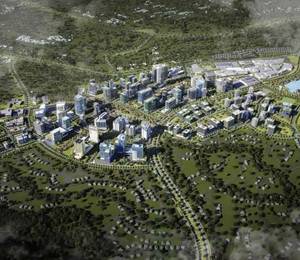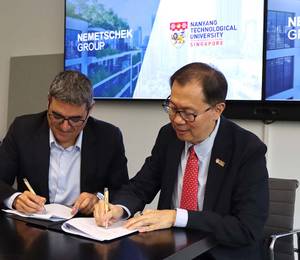Developed in the 1980s, Tseung Kwan O (TKO) is the seventh new town in Hong Kong that is home to a population of 414,000. To improve the district’s accessibility and to cope with the continuing increase in transport demand between TKO and East Kowloon, the Hong Kong Government worked on the Tseung Kwan O – Lam Tin Tunnel (TKO-LTT) as an additional and alternative highway route.
TKO-LTT is a dual two-lane highway featuring approximately 3.8 km long. It incorporates several bridges and a 2.2-km main tunnel. Construction work commenced in 2016 and TKO-LTT was opened to the public in December 2022.
Aurecon played a major role in the project, helping to build the TKO interchange and TKO-LTT main tunnel. In this article, the team shares the challenges involved and the innovative solutions applied in order to carry out the job successfully.
Challenging bridge
Aurecon was commissioned by Chun Wo – Shanghai Tunnel – China Metallurgical Joint Venture (CW-STEC-CMGC-JV) to deliver structural, geotechnical and temporary design works for the bridge component of the TKO Interchange and Associated Works contract. The job was completed in 2019.
This new elevated interchange over the sea, which consists of seven post-tensioned concrete bridges, was erected using the precast segmental balanced cantilever method. The bridges also form a part of Route 6 – a major new link between the New Territories and Kowloon.
Designing and constructing these seven bridges over the marine zone that pose aggressive environmental conditions were quite a challenge, revealed Aurecon. Some of the complexities included: heavy wave actions, onshore wind and water seepage; highly curved road geometry alignments; precast segmental single box deck; balanced cantilever construction method; and narrow deck with complex structural details.
Aurecon stressed that accurate assessments of exposure severity were vital to determine appropriate approaches with sufficient durability. Based on the requirement, the bridges must be designed and built for a design life of 120 years. To ensure the structure is resilient to the extreme natural events, the piles for the bridges were founded in competent rock with some pile lengths exceeding 50 m.
With the bridges constructed over the sea, the geological longitudinal section of the rock goes as deep as 50 m below sea level requiring longer piles, while the bridge piers have piles cantilevering reaching to 20 m from the seabed. Aurecon selected the method of erection, ensuring the geometry of the bridge superstructures met the required tolerances.
Geometry control work comprised the development of segment casting geometry, provision of segment data for individual segment match casting work at the precast yard, and on-site erection geometry control work during segment erection. In addition, Aurecon worked closely with the contractor to avoid step joints between the T-spans.
The bridges have extreme tight curvature with radii as low as 44 m, added Aurecon. The geometric behaviour of the bridges are more complicated than straight bridges with inherent challenges. To address this, the project team avoided using external post-tensioning but adopted internal tendons. This approach saved the cost of erecting closely spaced deviators and resulted in better constructability.
Another challenge for Aurecon was to successfully construct the precast segmental bridges in the marine zone with minimal disturbance to the natural environment while providing design solutions for the works to be carried out safely.
Aurecon strived to integrate safety in both the design and construction phases to ensure that workers were protected against any unnecessary exposure of potentially unsafe matters. This initiative also helps to reduce the amount of future maintenance works by enhancing the durability of the permanent works. Measures taken included:
-
Adopting precast shells to enhance work safety and reduce disturbance to the environment.
-
Fulfilling the crack width limits on the pile cap shell to enhance durability; this helps reduce long-term repair work and maintenance requirement at sea.
-
Utilising modularisation to minimise manual works in the sea.
-
Adopting a simpler method of shell installation and integration with permanent works.
-
Deploying Aurecon’s in-house digital experts and developed 3D geometrical models for plate element analysis for clash detection and better determinations of design actions.
The power of GIS
Aurecon was also engaged by Leighton and China State JV to provide contractor’s design such as TKO portal caverns and connection to Eastern Harbour Crossing under Lei Yue Mun Road for the TKO-LTT – Main Tunnel and Associated Works contract. The job was completed in 2022.
The main tunnel and a significant amount of surface works were excavated using the drill and blast method. With a geology of mostly hard granite, this approach was deemed the most effective.
As the drill and blast excavation for the tunnel would navigate through a densely populated area, Aurecon pointed out that it was critical for the operation’s effects on the environment and Hong Kong citizens to be thoroughly assessed and minimised.
There were two main environmental considerations for the drill and blast excavation: vibration (transmitted through the rock, measured as peak particle velocity), and air overpressure (the shockwave of audible and inaudible ‘noise’ generated at a blast).
According to Aurecon, the use of a geographic information system (GIS) for the project’s blast assessments avoided the need to manually engineer vibration contours and produced accurate 3D visualisations of blast plumes.
At the beginning of the project, the drill and blast calculations were being managed in Excel spreadsheets and the vibration contours were manually generated by CAD drafters, explained Aurecon.
Upon learning of this manual process, the company’s Auckland-based GIS team knew that a spatial solution would bring better results. So it chose a GIS platform which primarily managed large quantities of geological and engineering data within a single database, while efficiently completing extensive calculations and outputting two dimensional (2D) contours for drafting.
To design a suitable GIS platform for the TKO-LTT – Main Tunnels and Associated Works, a collaboration between Aurecon’s Auckland and Hong Kong teams was required, leading to a platform that was more efficient and much easier to use.
Besides presenting clients with clearer data quicker and more accurately, while the GIS platform was in development, there were other potential benefits of the application such as stakeholder and community consultation.
“Modern-day drill and blast is nothing like the evoked vision of workers hammering away in tunnels with chisels, mechanically tapping holes and filling them with unpredictable dynamite,” said Aurecon.
“Some stakeholders and communities are not familiar with the new methods of excavation by drill and blast, and are rightfully protective of their assets as there are thousands of historic buildings in Hong Kong.
“Thus, the 3D visualisations produced from the data in GIS may help to educate stakeholders about the drill and blast process and alleviate concerns over the project.”
All images: Aurecon
Note: This article has also been published in the Mar/Apr 2023 issue of Southeast Asia Construction. Click here to read online or here to download the PDF file (pages 48-51).















